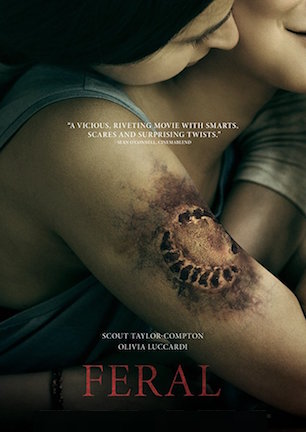Studio: IFC Midnight
Director: Mark H. Young
Writer: Mark H. Young, Adam Frazier
Producer: John Landolfi, Mark H. Young
Stars: Scout Taylor-Compton, Olivia Luccardi, Lew Temple, Renee Olstead, Brock Kelly, Landry Allbright, George Finn
Review Score:
Summary:
Six friends stranded in the woods fight to survive against a mysterious virus that turns humans feral.
Review:
Someone curious about seeing “Feral” in a theater asked on Twitter, “is it worth a drive into Hollywood?” I considered replying, “it wasn’t worth the walk to my television to watch it on VOD.”
“Feral’s” pre-title prologue opens on a bloody woman restrained to a table in a dungeon-like basement. In the midst of a violent transformation, the woman howls. Her animal eyes are glimpsed only briefly thanks to a hanging bulb swaying back and forth overhead. An unseen man pulls a gun and fires.
Did we just witness a murder? Not exactly. We witnessed a non-sequitur cold open without context, the kind used to start a thriller with a thrill because the next 13 minutes are nothing but ultimately unused exposition.
Med school student Alice has hiked into remote woods with her new girlfriend Jules. This could be a great getaway for the couple except someone thought it made sense to bring Jesse, a classmate who had a brief fling with Alice. Jesse isn’t handling Alice’s sexuality switch diplomatically, which in turn creates discord between Jesse and his current girlfriend Gina.
While Alice and Jules have an argument about Alice’s unwillingness to come out to her father, Matt and Brienne confront their own issues in a third tent. Jules sniffs Brienne as a potential romantic rival, despite Alice’s assurances to the contrary as well as the fact that Matt just gave Brienne a ring.
Having established who’s who, “Feral” crosses its arms with satisfaction that a sufficient character background threshold has been reached. Aside from a mid-movie conversation where Alice adds another bit of blasé backstory about hunting with her father, this is the last time any of the above has any relevancy. It’s time to put horror in hand by putting the premise in play.
After gifting the ring and kissing for ten seconds, Matt quickly excuses himself with an, “I’ll be right back,” which isn’t even close to being the film’s only clichéd line of dialogue. Following more fright flick formula, Matt exits his tent to take a leak, yet picks a tree so far from camp that no one hears him scream when a creature attacks. Who walks a mile to pee other than hikers in horror films?
Brienne makes more of a commotion when she subsequently stumbles upon Matt’s body and also ends up mauled. The other four friends find Brienne, bring her back to camp, and make the first of three, count ‘em three, decisions to “wait until morning” before taking further action.
When they wake, the group meets mysterious woodsman Talbot, because Frankenstein, Dracula, or Imhotep would be too on-the-nose for a last name. Cryptic and cagey, Talbot escorts everyone to his conveniently nearby cabin where they can better care for Brienne. In the meantime, someone has to find help.
At this point, “Feral” shows it either doesn’t care or doesn’t understand how relationship dynamics are intended to operate to foster drama and character development. From the earlier exposition, key conflicts clearly exist in Jesse having to reconcile Alice’s homosexuality in light of their previous hookup, in Alice deepening her connection to Jules, and in Gina forcing Jesse to face his true feelings for her and Alice.
Yet without so much as a discussion, the two remaining couples inexplicably split so that Jesse hikes for help with Jules while Alice stays behind with Gina. “Feral” abandons any intentions of treating Alice’s lesbian love affair, push and pull with Jules over failing to face her father, or other relationship rifts as anything other than superficial mirages of progressive protagonists with personality. Excise that short first act and everyone from this moment forward is an entirely interchangeable pusher of plot progression.
Which is why the audience struggles to find a shred of emotional investment when transformations start taking place and animalistic attacks ensue. “Feral” features hollow horror. Mutated men remain in street clothes while their faces morph into Plain Jane monsters. Makeup effects are serviceable, although you’d never pay money to have a “Feral” mask for Halloween for fear of being the blandest boogeyman at the party.
Scout Taylor-Compton can’t save Alice from being a terrible heroine. Alice consistently ignores factual information, even with evidence inches from her face, and does so at the expense of endangering every one of her friends. She takes rash actions (shooting Talbot before he explains a misunderstanding), makes poor choices (repeatedly recommending going to sleep and waiting for another sunrise), and generally acts like anything other than a compassionate aspiring doctor (leaving Matt’s body in the woods and not regularly remaining with Brienne). Alice is one more element of “Feral” built for basic function without any interestingly original shape.
“Feral” frustrates because of how easily one can identify casual carelessness, which directly relates to its desire to move the movie without rationalizing fiction. Why is the second person infected the last person to turn? Why task Talbot with saying, “I’m gonna turn in for the night,” yet stage the scene with the sun still blazing outside a window? Why did it take two people to write such a straightforward script? “Feral” poses countless questions logical minds can’t answer, including, why would anyone want to watch this indistinguishably below average movie?
Review Score: 35







If you want to see impossible amounts of blood explode crimson colors like the world’s worst version of a gender reveal, well, “Abigail” at least has that.